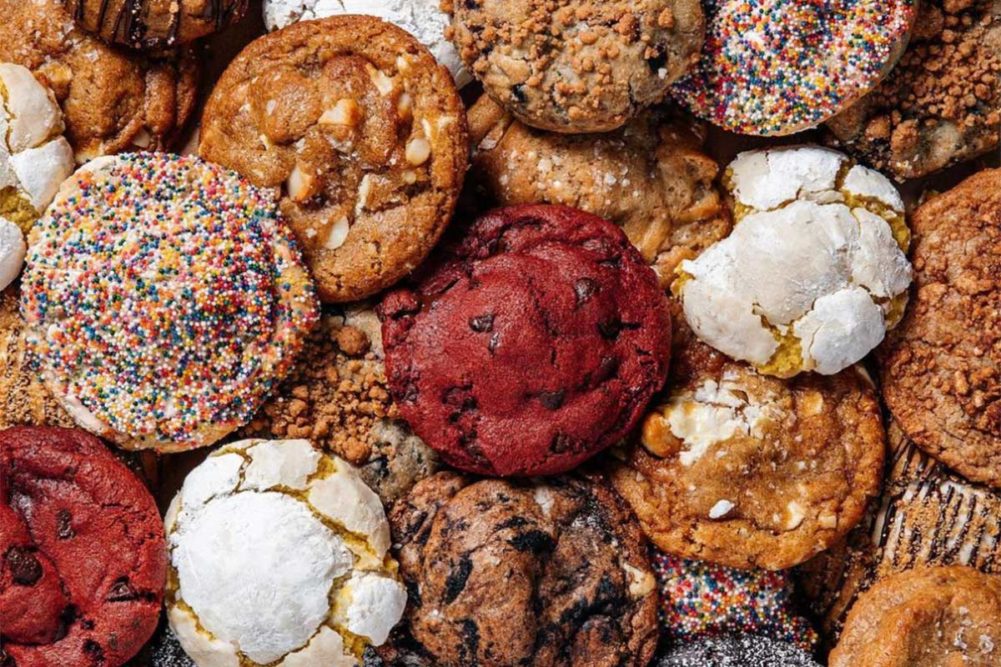While better-for you (BFY) cookies are more popular than ever, taste remains the main predictor in whether consumers will come back for more. This means brands still need to prioritize the flavor and indulgence people expect from a cookie.
Last Crumb, for example, has made premium indulgence the center of its brand. The Los Angeles-based luxury cookie company uses a unique drop model in which cookies are released on a weekly basis to customers on an exclusive list. The cookies, which are handmade using a three-day dough preparation process, include inventive flavors such as The Donkey Kong (banana cream pie), The James Dean (Oreo milkshake), and Netflix and Crunch (Cinnamon Toast Crunch).
“We continue to see demand from consumers looking to treat themselves with elevated experiences, such as Last Crumb,” said Alana Arnold, the company’s co-founder and director of operations.
Just as important as indulgence are flavors that induce a sense of nostalgia with consumers, said Caroline Ponsi, sales director for Mmmly, New York.
“Peanut butter that reminds consumers of a Nutter Butter, for example, or a blueberry shortbread that reminds someone of the taste of a decadent blueberry muffin — the more you can provide an image for someone visually, paired with the idea created within your mind when you hear that product, the better,” she said.
Love + Chew, San Francisco has capitalized on the nostalgia trend with its Banana Bread cookie, which founder Lauren Chew says is the brand’s top seller by far.
And Chicago-based Mondelez International’s Oreo brand has expanded its portfolio with nostalgic and innovative varieties, including Toffee Crunch, Java Chip, Carrot Cake and even a limited-edition Tiramisu flavor.
The brand’s outside-the-box offerings have driven enduring excitement and demand for the iconic cookie, helping make it the eighth-fastest growing food brand globally in 2022, with a 47% increase in brand value, according to Brand Finance Food and Drink.
Unique flavors like these are created to pique consumer interest and can find great success, but they will still often be outshined by classics like chocolate chip, sugar and peanut butter, at least in sales, pointed out pointed out. In fact, more than a third of cookie dollar sales in 2022 came from the top two chocolate flavors: Chocolate Chip and Chocolate, IRI reported.
These traditional fan favorites can still be spiced up, however, and cookie makers are enhancing their staples to win over consumers.
“We try to elevate our flavors in the ways we can,” said Caroline Cotto, co-founder and chief operating officer of Renewal Mill, San Francisco. “It’s not just a peanut butter cookie we offer, it’s a salted peanut butter cookie, and we think it gives it a little more of that premium-ness.”
The Campbell Soup Co.’s Pepperidge Farm brand, Norwalk, Conn., continues to succeed with its indulgent take on classic offerings, including its European-inspired Chessman Butter cookies and Double Dark Chocolate Milano cookies. Pepperidge Farm is the second most popular center-store cookie brand behind Nabisco in terms of dollar sales, according to IRI.
“Flavor and premium quality, which you can find in all Pepperidge Farm cookies, will continue to be a focus across the cookie category, as well as our business,” said Danielle Brown, vice president of marketing, cookies and crackers, Campbell Snacks. “Keep an eye out for exciting new flavors in our portfolio as we continue to keep up with consumer demand and the flavor trend landscape.”
Other brands are putting an entirely new spin on their iconic cookies. Chicago-based Ferrara’s Keebler brand introduced Fudge Stripe Dip’mmms, pairing dippable marshmallow frosting with mini versions of its classic Keebler Fudge Stripes.
In addition to plenty of new flavors, brands are maintaining relevancy by introducing more special occasions throughout the day to enjoy cookies.
“Thinking about those occasions across the day, and the different consumer groups across the day, you can mine that to find opportunities for growth,” noted Sally Lyons Wyatt, executive vice president and practice leader, IRI.
Mmmly markets its cookies as an anytime snack that reinvents when it’s OK to enjoy indulgent treats, which many people see strictly as a dessert or reward they have to “earn the right” to eat, Ms. Ponsi said.
“Our mission is to reshape that idea that you need to limit yourself, or you can only have something after you’ve done something else,” she said. “We have developed these products as an anytime snack because we want to change that perspective. They’re something that actually fuels your day and can give you the energy to go for a workout or to sit down and crank out a big project.”
Brands are also broadening cookie occasions by marketing them in different areas of the grocery store. Renewal Mill has found success merchandising their cookies in the deli area, as well as grab-n-go sections, for example.
“It’s like, ‘Oh, you’re picking up a sandwich for lunch and a bag of chips. Throw in a packaged cookie,’ ” Ms. Cotto said. “We definitely emphasize being a midafternoon slump kind of snack, or a pick me-up or on-the-go snack.”
Another opportunity is promoting new flavors and limited-time offerings (LTOs) throughout different times of the year. Oreo has a variety of LTOs centered around holidays and seasons, including Gingerbread, S’Mores, Easter Egg and Neapolitan flavors.
And earlier this year Keebler launched limited-edition Mario Kart Fudge Stripes Rocky Road, capitalizing on the classic combo of gaming and snacking, in addition to new LTO flavors for Valentine’s Day and Easter.
These offerings are just a few of the many ways brands are refreshing the category to keep consumers’ cookie cravings going strong.
“Listening to consumers’ ever evolving needs and desires is key for growth,” said Alicia Mosley, vice president of marketing for Keebler Brands. “It fuels our innovations and inspires us.”
This article is an excerpt from the October 2022 issue of Baking & Snack. To read the entire feature on Cookies, click here.





